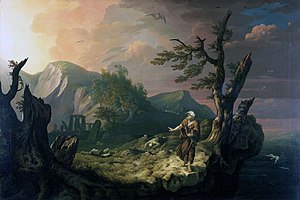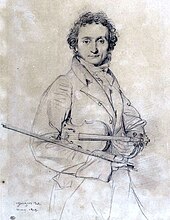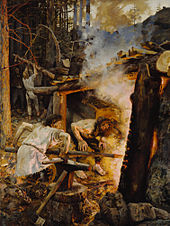THE ROMANTIC PERIOD
The Romanticism: (or the Romantic era/Period) was an artistic, literary, and intellectual movement that originated in Europe toward the end of the 18th century and in most areas was at its peak in the approximate period from 1800 to 1840. Partly a reaction to the Industrial Revolution, it was also a revolt against aristocratic social and political norms of the Age of Enlightenment and a reaction against the scientific rationalization of nature.It was embodied most strongly in the visual arts, music, and literature, but had a major impact on historiography, education and the natural sciences. Its effect on politics was considerable and complex; while for much of the peak Romantic period it was associated with liberalism and radicalism, in the long term its effect on the growth of nationalism was probably more significant.

The movement validated strong emotion as an authentic source of aesthetic experience, placing new emphasis on such emotions as apprehension, horror and terror, and awe—especially that which is experienced in confronting thesublimity of untamed nature and its picturesque qualities, both new aesthetic categories. It elevated folk art and ancient custom to something noble, made spontaneity a desirable characteristic (as in the musical impromptu), and argued for a "natural" epistemology of human activities as conditioned by nature in the form of language and customary usage. Romanticism reached beyond the rational and Classicist ideal models to elevate a revivedmedievalism and elements of art and narrative perceived to be authentically medieval in an attempt to escape the confines of population growth, urban sprawl, and industrialism, and it also attempted to embrace the exotic, unfamiliar, and distant in modes more authentic than Rococo chinoiserie, harnessing the power of the imagination to envision and to escape.
Basic characteristics
Defining the nature of Romanticism may be approached from the starting point of the primary importance of the free expression of the feelings of the artist. The importance the Romantics placed on untrammelled feeling is summed up in the remark of the German painterCaspar David Friedrich that "the artist's feeling is his law". To William Wordsworth poetry should be "the spontaneous overflow of powerful feelings".In order to truly express these feelings, the content of the art must come from the imagination of the artist, with as little interference as possible from "artificial" rules dictating what a work should consist of. Coleridge was not alone in believing that there were natural laws governing these matters which the imagination, at least of a good creative artist, would freely and unconsciously follow through artistic inspiration if left alone to do so.[9] As well as rules, the influence of models from other works would impede the creator's own imagination, so originality was absolutely essential. The concept of the genius, or artist who was able to produce his own original work through this process of "creation from nothingness", is key to Romanticism, and to be derivative was the worst sin.[This idea is often called "romantic originality.
The period
Unsurprisingly, given its rejection on principle of rules, Romanticism is not easily defined, and the period typically called Romantic varies greatly between different countries and different artistic media or areas of thought. Margaret Drabble described it in literature as taking place "roughly between 1770 and 1848",and few dates much earlier than 1770 will be found. In English literature, M. H. Abrams placed it between 1789, or 1798, this latter a very typical view, and about 1830, perhaps a little later than some other critics.In other fields and other countries the period denominated as Romantic can be considerably different; musical Romanticism, for example, is generally regarded as only having ceased as a major artistic force as late as 1910, but in an extreme extension the Four Last Songs of Richard Strauss are described stylistically as "Late Romantic" and were composed in 1946–48. However in most fields the Romantic Period is said to be over by about 1850, or earlier.
The early period of the Romantic Era was a time of war, with the French Revolution (1789–1799) followed by the Napoleonic Wars until 1815. These wars, along with the political and social turmoil that went along with them, served as the background for Romanticism.The key generation of French Romantics born between 1795–1805 had, in the words of one of their number, Alfred de Vigny, been "conceived between battles, attended school to the rolling of drums".
Context and place in history
The more precise characterization and specific definition of Romanticism has been the subject of debate in the fields of intellectual history and literary history throughout the 20th century, without any great measure of consensus emerging. That it was part of theCounter-Enlightenment, a reaction against the Age of Enlightenment, is generally accepted. Its relationship to the French Revolutionwhich began in 1789 in the very early stages of the period, is clearly important, but very variable depending on geography and individual reactions. Most Romantics can be said to be broadly progressive in their views, but a considerable number always had, or developed, a wide range of conservative views, and nationalism was in many countries strongly associated with Romanticism, as discussed in detail below.
Romantic literature
In literature, Romanticism found recurrent themes in the evocation or criticism of the past, the cult of "sensibility" with its emphasis on women and children, the heroic isolation of the artist or narrator, and respect for a new, wilder, untrammeled and "pure" nature. Furthermore, several romantic authors, such as Edgar Allan Poe and Nathaniel Hawthorne, based their writings on the supernatural/occult and human psychology. Romanticism tended to regard satire as something unworthy of serious attention, a prejudice still influential today.
The precursors of Romanticism in English poetry go back to the first half of the 18th century, with figures such as Joseph Warton (headmaster at Winchester College) and his brother Thomas Warton, professor of Poetry at Oxford University Joseph maintained that invention and imagination were the chief qualities of a poet. Thomas Chatterton is generally considered to be the first Romantic poet in English.The Scottish poet James Macpherson influenced the early development of Romanticism with the international success of his Ossiancycle of poems published in 1762, inspiring both Goethe and the young Walter Scott. Both Chatterton and Macpherson's work involved elements of fraud, as what they claimed to be earlier literature that they had discovered or compiled was in fact entirely their own work. The Gothic novel, beginning with Horace Walpole's The Castle of Otranto (1764), was an important precursor of one strain of Romanticism, with a delight in horror and threat, and exotic picturesque settings, matched in Walpole's case by his role in the earlyrevival of Gothic architecture. Tristram Shandy, a novel by Laurence Sterne (1759–67) introduced a whimsical version of the anti-rationalsentimental novel to the English literary public.
Romantic visual arts
In the visual arts, Romanticism first showed itself in landscape painting, where from as early as the 1760s British artists began to turn to wilder landscapes and storms, and Gothic architecture, even if they had to make do with Wales as a setting. Caspar David Friedrich and J. M. W. Turner were born less than a year apart in 1774 and 1775 respectively and were to take German and English landscape painting to their extremes of Romanticism, but both were formed when forms of Romanticism was already strongly present in art. John Constable, born in 1776, stayed closer to the English landscape tradition, but in his largest "six-footers" insisted on the heroic status of a patch of the working countryside where he had grown up, a challenge to the traditionalhierarchy of genres which relegated landscape painting to a low status. Turner also painted very large landscapes, and above all seascapes, some with contemporary settings and staffage, but others with small figures turning the work into a history painting in the manner of Claude Lorrain, like Salvator Rosaa late Baroque artist whose landscapes had elements that Romantic painters turned to again and again. Friedrich made repeated use of single figures, or features like crosses, set alone amidst a huge landscape, "making them images of the transitoriness of human life and the premonition of death"
Romanticism and music
Musical romanticism is predominantly a German phenomenon—so much so that one respected French reference work defines it entirely in terms of "The role of music in the esthetics of German romanticism".Another French encyclopedia holds that the German temperament generally "can be described as the deep and diverse action of romanticism on German musicians", and that there is only one true representative of romanticism in French music, Hector Berlioz, while in Italy, the sole great name of musical romanticism is Giuseppe Verdi, "a sort of [Victor] Hugo of opera, gifted with a real genius for dramatic effect". Nevertheless, the huge popularity of German Romantic music led, "whether by imitation or by reaction", to an often nationalistically inspired vogue amongst Polish, Hungarian, Russian, Czech, and Scandinavian musicians, successful "perhaps more because of its extra-musical traits than for the actual value of musical works by its masters".
Although the term "Romanticism" when applied to music has come to imply the period roughly from 1800 until 1850, or else until around 1900, the contemporary application of "romantic" to music did not coincide with this modern interpretation. Indeed, one of the earliest sustained applications of the term to music occurs in 1789, in the Mémoires of André Grétry. This is of particular interest because it is a French source on a subject mainly dominated by Germans, but also because it explicitly acknowledges its debt to Jean-Jacques Rousseau (himself a composer, amongst other things) and, by so doing, establishes a link to one of the major influences on the Romantic movement generally. In 1810 E.T.A. Hoffmannnamed Mozart, Haydn and Beethoven as "the three masters of instrumental compositions" who "breathe one and the same romantic spirit". He justified his view on the basis of these composers' depth of evocative expression and their marked individuality. In Haydn's music, according to Hoffmann, "a child-like, serene disposition prevails", while Mozart (in the late E-flat major Symphony, for example) "leads us into the depths of the spiritual world", with elements of fear, love, and sorrow, "a presentiment of the infinite … in the eternal dance of the spheres". Beethoven's music, on the other hand, conveys a sense of "the monstrous and immeasurable", with the pain of an endless longing which "will burst our breasts in a fully coherent concord of all the passions". This elevation in the valuation of pure emotion resulted in the promotion of music from the subordinate position it had held in relation to the verbal and plastic arts during the Enlightenment. Because music was considered to be free of the constraints of reason, imagery, or any other precise concept, it came to be regarded, first in the writings of Wackenroder and Tieck and later by writers such as Schelling and Wagner, as preeminent among the arts, the one best able to express the secrets of the universe, to evoke the spirit world, infinity, and the absolute.
Romanticism outside the arts
The Romantic movement affected most aspects of intellectual life, and Romanticism and science had a powerful connection, especially in the period 1800–40. Many scientists were influenced by versions of the Naturphilosophie of Johann Gottlieb Fichte, Friedrich Wilhelm Joseph von Schelling and Georg Wilhelm Friedrich Hegel and others, and without abandoning empiricism, sought in their work to uncover what they tended to believe was a unified and organic Nature. The English scientist SirHumphry Davy, a prominent Romantic thinker, said that understanding nature required “an attitude of admiration, love and worship, […] a personal response.” He believed that knowledge was only attainable by those who truly appreciated and respected nature. Self-understanding was an important aspect of Romanticism. It had less to do with proving that man was capable of understanding nature (through his budding intellect) and therefore controlling it, and more to do with the emotional appeal of connecting himself with nature and understanding it through a harmonious co-existence.
History was very strongly, and many would say harmfully, influenced by Romanticism. In EnglishThomas Carlyle was a highly influential essayist who turned historian, and both invented and exemplified the phrase "hero-worship", lavishing largely uncritical praise on strong leaders such asOliver Cromwell, Frederick the Great and Napoleon. Romantic nationalism had a largely negative effect on the writing of history in the 19th century, as each nation tended to produce its own version of history, and the critical attitude, even cynicism, of earlier historians was often replaced by a tendency to create romantic stories with clearly distinguished heroes and villains. Nationalist ideology of the period placed great emphasis on racial coherence, and the antiquity of peoples, and tended to vastly over-emphasize the continuity between past periods and the present, leading to national mysticism. Much historical effort in the 20th century was devoted to combating the historical myths created in the 19th century.
To insulate theology from reductionism in science, 19th century post-Enlightenment German theologians moved in a new direction, led by Friedrich Schleiermacher and Albrecht Ritschl. They took the Romantic approach of rooting religion in the inner world of the human spirit, so that it is a person's feeling or sensibility about spiritual matters that comprises religion.
Romantic authors
- Joanna Baillie
- Anna Barbauld
- William Blake
- Robert Burns
- Brontë family
- Lord Byron
- Thomas Carlyle
- François-René de Chateaubriand
- Samuel Taylor Coleridge
- Maria Edgeworth
- Ralph Waldo Emerson
- José de Espronceda
- William Godwin
- Johann Wolfgang von Goethe
- William Hazlitt
- Heinrich Heine
- James Hogg
- Victor Hugo
- Leigh Hunt
- Elizabeth Inchbald
- Washington Irving
- John Keats
- James Kenney
- Charles Lamb
- Mikhail Lermontov
- Adam Mickiewicz
- Hannah More
- Adam Oehlenschläger
- Edgar Allan Poe
- Alexander Pushkin
- Mary Robinson (poet)
- Friedrich Schleiermacher
- Walter Scott
- Mary Shelley
- Percy Shelley
- Erik Johan Stagnelius
- Stendhal
- Henry David Thoreau
- Mary Wollstonecraft
- William Wordsworth
- Ann Yearsley





No hay comentarios:
Publicar un comentario